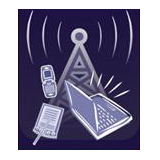
XXV Simpósio Brasileiro de Telecomunicações
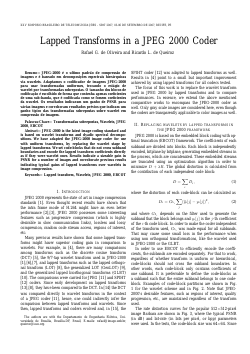
Lapped Transforms in a JPEG 2000 Coder
Rafael Oliveira, Ricardo de Queiroz
DOI: 10.14209/sbrt.2007.31317
Keywords: Transformadas sobrepostas Wavelets JPEG 2000 EBCOT
Abstract
JPEG-2000 is the latest image coding standard and is based on wavelet transforms and dyadic spectral decompositions. We have adapted the JPEG-2000 image coder for use with uniform transforms, by replacing the wavelet stage by lapped transforms. We set code-blocks that do not cross subband boundaries and encode the lapped transform coefficients directly as if they were wavelet ones. Results indicate a sizeable gain in PSNR for a number of images and corroborate previous results indicating typical gains of lapped transforms over wavelets in image compression.Download
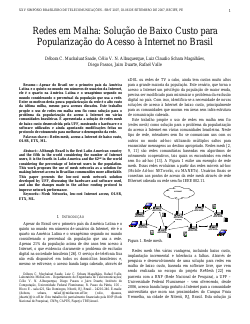
Redes em Malha: Solução de Baixo Custo para Popularização do Acesso à Internet no Brasil
Debora Muchaluat-Saade, Célio Vinicius Neves de Albuquerque, Luis Claudio Magalhaes, Diego Passos, Jairo Duarte, Rafael do Valle
DOI: 10.14209/sbrt.2007.31318
Keywords: Redes mesh acesso a Internet de baixo custo OLSR ETX ML
Abstract
Apesar do Brasil ser o primeiro país da América Latina e o quinto no mundo em números de usuários da Internet, ele é o quarto na América Latina e o sexagésimo segundo no mundo considerando o percentual da população que usa a rede. Entre os motivos desta pouca popularização da rede é o alto custo da última milha, mesmo para acessos discados. Este trabalho propõe o uso de redes em malha sem fio como solução para o problema da popularização do acesso à Internet em várias comunidades brasileiras. É apresentada a solução de redes mesh de baixo custo desenvolvida pela UFF, mostrando o hardware e o software utilizados e ainda apontando modificações feitas no protocolo de roteamento para melhorar o desempenho da rede.Download

Análise de um guia de onda metálico preenchido por um dielétrico estratificado.
Vladimir Soares, Tassio Anaissi, Luiz Junior, Fabrício Souza
DOI: 10.14209/sbrt.2007.31319
Keywords: Microondas Guias de Onda Redes de Bragg Matriz de Transferência
Abstract
Nesse trabalho apresentamos uma formulação teórica que permite descrever transmissão de ondas eletromagnéticas em guias de onda com redes de Bragg. A análise do sinal eletromagnético transmitido e refletido é feita por meio do método de Matriz de Transferência. Nossa formulação é válida para guias retangulares e cilíndricos. Possíveis aplicações em transmissão de dados e redução de ruído em guias de onda serão brevemente discutidas.Download

Inverse QRD BEACON Algorithm
Jose Apolinario Jr., Mobien Shoaib, Stefan Werner
DOI: 10.14209/sbrt.2007.31320
Keywords: Filtragem adaptativa Filtragem SetMembership filtering Algoritmos com decomposição QR
Abstract
This paper derives the inverse QR-decomposition (IQRD) version of the Bounding Ellipsoidal Adaptive CONstrained least-squares (BEACON) algorithm. The BEACON algorithm belongs to the family of set-membership filtering (SMF) algorithms that feature sparse updating in time and good tracking capability. The prominent characteristic of sparse updating in SMF arises from a predefined bounded error-constraint specified in the filter design. As a consequence, a set of valid coefficient vector estimates will conform to the constraint rather than a single point-estimate. The choice of the error constraint appears naturally in various signal processing applications, e.g., when model-order is unknown or distance between constellation points is a priori known in a decision-feedback equalizer. The new algorithm, the IQRD-BEACON, implements the same objective function as BEACON and will, therefore, in infinite-precision environment present identical results in terms of learning curves and update frequency. The advantage of the IQRD-BEACON comes with the use of numerically stable rotations in the update equations, thus avoiding the use of the ill-conditioned recursions associated with the matrix-inversion lemma employed in the conventional BEACON. Our claims regarding the performance of the IQRD-BEACON are verified through computer simulations.Download

Evaluation of DSM Performance with Mixed DSL Services and Measured Crosstalk Channels
Neiva Fonseca, D. Neves, Ana Gomes, Marcio Conte, Aldebaro Klautau, Evaldo Gonçalves Pelaes
DOI: 10.14209/sbrt.2007.31321
Keywords: Digital Subscriber Lines Power Allocation Dynamic Spectrum Management (DSM) FEXT Crosstalk
Abstract
In most works published so far, dynamic spectrum management (DSM) techniques are simulated assuming a single service (e.g. ADSL) and classical copper-pair channel models described in standards for spectrum management. This work presents an evaluation of DSM algorithms based on measured channels and with multiple services. A measurement campaign was performed to completely characterize scenarios by measuring the direct and far-end crosstalk transfer functions. Results for a total of two scenarios of ten twisted pairs (200 measurements), involving both equal and non-equal length cables are presented. The work also presents a thorough investigation of state-ofart DSM algorithms (namely, ISB, ASB, SCALE and IWF) simulated in multiple services (namely, ADSL, ADSL2+ and VDSL2) scenarios.Download
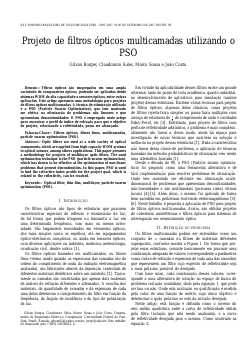
Projeto de filtros ópticos multicamadas utilizando o PSO
Gilvan Borges, Claudomiro Souza Junior
DOI: 10.14209/sbrt.2007.31323
Keywords: Filtros ópticos filmes finos multicamadas particle swarm optimization (PSO)
Abstract
Filtros ópticos são empregados em uma ampla variedade de componentes ópticos, podendo ser aplicados desde sistemas WDM de alta capacidade a sensores ópticos, entre outras aplicações. Este artigo apresenta uma metodologia para projetos de filtros ópticos multicamadas. A técnica de otimização utilizada é o PSO (Particle Swarm Optimization), que tem mostrado ser efetiva na otimização de problemas não lineares e que apresentam descontinuidades. O PSO é empregado neste artigo para encontrar o perfil de ı́ndice de refração para que o objetivo de projeto, relacionado à refletividade, possa ser alcançado.Download
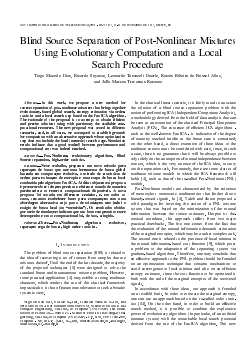
Blind Source Separation of Post-Nonlinear Mixtures Using Evolutionary Computation and a Local Search Procedure
Tiago Dias, Ricardo Suyama, Romis Attux, João Romano
DOI: 10.14209/sbrt.2007.31325
Keywords: Post-Nonlinear evolutionary algorithms Blind Source separation high-order statistics
Abstract
In this work, we propose a new method for source separation of post-nonlinear mixtures that brings together evolutionary-based global search, entropy estimation via order-statistics and a local search step based on the FastICA algorithm. The rationale of the proposal is to attempt to obtain eficient and precise solutions using with parsimony the available computational resources. The new proposal was tested in different scenarios, and, in all cases, we attempted to establish grounds for comparison with an alternative approach whose optimization step does not include the local (memetic) search stage. Simulation results indicate that a good tradeoff between performance and computational cost was indeed reached.Download
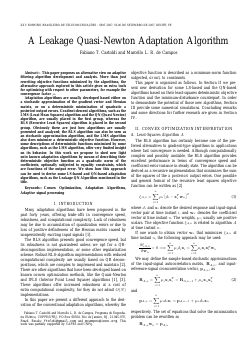
A Leakage Quasi-Newton Adaptation Algorithm
Marcello Campos, Fabiano T Castoldi
DOI: 10.14209/sbrt.2007.31326
Keywords: Convex Optimization Adaptation Algorithms Adaptive signal processing
Abstract
This paper proposes an alternative view on adaptive filtering algorithm development and analysis. More than just rewriting objective functions minimized by the algorithms, the alternative approach explored in this article gives us extra tools for optimizing with respect to other parameters, for example the convergence factor µ. Adaptation algorithms are usually developed based either on a stochastic approximation of the gradient vector and Hessian matrix, or on a deterministic minimization of quadratic a posteriori output errors. Gradient-descent algorithms, such as the LMS (Least Mean Squares) algorithm and the QN (Quasi Newton) algorithm, are usually placed in the first group, whereas the RLS (Recursive Least Squares) algorithm is placed in the second group. Obviously these are just how algorithms are usually presented and analyzed; the RLS algorithm can also be seen as an stochastic approximation algorithm, and the LMS algorithm also does minimize a deterministic objective function. However, some descriptions of deterministic functions minimized by some algorithms, such as the LMS algorithm, offer very limited insight on its behavior. In this work we propose to shed new light onto known adaptation algorithms by means of describing their deterministic objective function as a quadratic norm of the coefficients, optionally subjected to equality constraints, which are functions of the output error. We show how this approach can be used to derive some LS-based and QN-based adaptation algorithms, such as the Leakage QN Algorithm mentioned in the title.Download

Simulações com uso de códigos de treliça e decodificação iterativa para o canal aditivo binário
Maria de Lourdes Alcoforado, Valdemar da Rocha Jr., Garik Markarian
DOI: 10.14209/sbrt.2007.31327
Keywords: Acesso múltiplo canal aditivo códigos turbo
Abstract
Este artigo apresenta resultados de simulações computacionais para códigos de treliça sobre o canal aditivo para dois usuários binários, em presença de ruı́do branco gaussiano aditivo. São comparados os desempenhos de diferentes códigos de treliça com e sem o uso de decodificação iterativa.Download

Um esquema em duas camadas para suporte à mobilidade em redes de sensores sem fio
Filippe Jabour Neto, Eugenia Giancoli, Aloysio de Castro Pinto Pedroza
DOI: 10.14209/sbrt.2007.31330
Keywords: Redes de sensores sem fio mobilidade agentes móveis
Abstract
Este artigo propõe um esquema em dois nı́veis para o suporte à mobilidade em redes de sensores sem fio. Baseado em informações oriundas de algoritmos distribuı́dos de localização, agentes móveis executam um algoritmo de mobilidade controlada e cumprem a tarefa de sensoriamento na rede apesar da mobilidade aleatória dos nós sensores. Nós apresentamos o modelo de decisão e migração implementado no agente móvel. Foi desenvolvido e validado um simulador computacional e testes foram executados para avaliar a corretude do algoritmo proposto. Os resultados são apresentados e discutidos.Download